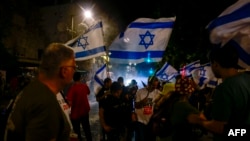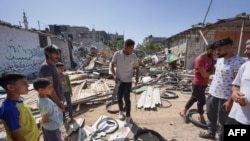Thousands of Israelis staged a mass demonstration in Jerusalem Monday to protest Prime Minister Benjamin Netanyahu’s handling of the war in Gaza.
The demonstration began outside the Knesset, Israel’s parliament, before making its way to Prime Minister Netanyahu’s personal residence. The protesters demanded the government negotiate with Hamas for a return of the remaining hostages who have been held by the Palestinian militant group since its deadly raid on southern Israel last October 7, as well as early parliamentary elections.
Reuters says some of the protesters broke off from the larger crowd and tried to break through police barricades. Security forces managed to push the protesters back, eventually using a water cannon to disperse the crowd.
The protests came hours after Netanyahu disbanded his war cabinet, a decision expected after Benny Gantz and Gadi Eisenkot, two centrist ex-generals, stepped down last week over disagreements with the prime minister over the direction of the war.
Gantz joined Netanyahu’s unity government in October at the start of the war and demanded the formation of the war cabinet.
The White House said Monday that the dissolution was an “internal” and “domestic” measure by Israel’s government, and the United States will continue to interact with Netanyahu.
At the State Department, spokesperson Matthew Miller told reporters during a briefing that it is not for the U.S. to decide who should be in the government of Israel.
However, Miller added that Washington will publicly express disagreements on policies “that we think are unproductive, not only to the plight of the Palestinian people but also to Israel's security,” when asked if the U.S. is concerned about far-right voices in Israel’s decision making.
The U.S. had said it was worthwhile to have the war cabinet in place.
Meanwhile, a daytime, 11-hour “tactical pause” in Israeli military operations in parts of the southern Gaza Strip took effect Monday.
Israel said the pause in its offensive in southern Gaza would continue for the immediate future and allow humanitarian aid trucks to reach the Israeli-controlled Kerem Shalom crossing, the main entry point for incoming aid. The trucks could then safely travel to a nearby highway to deliver desperately needed food and medical supplies to other parts of Gaza.
The "tactical pause" announced by the military applies to about 12 kilometers of road in the Rafah area but falls far short of a complete cease-fire in Gaza that the international community, including the United States, is pushing for Israel and Hamas to adopt. The proposed broader cease-fire would halt fighting throughout Gaza for six weeks and calls for the release of more hostages held by Hamas in exchange for Palestinians jailed by Israel.
But there was no sign of a breakthrough in the stalled cease-fire talks.
The limited halt in fighting, if it holds, could help address some of the overwhelming needs of Palestinians that have surged even more in recent weeks with Israel's incursion into Rafah.
Israel said the route out of southern Gaza would increase the flow of aid to other parts of Gaza, including Khan Younis, the Muwasi makeshift tent camp, and central Gaza. Hard-hit northern Gaza, which was an early target in the war, now in its ninth month, is being served by goods entering from a crossing in the north.
The military said the pause Sunday, which began as Muslims in Gaza and elsewhere celebrated the Eid Al-Adha holiday, came after discussions with the United Nations and international aid agencies.
The flow of aid in southern Gaza declined just as the humanitarian need grew. More than 1 million Palestinians, many of whom had already been displaced, fled Rafah after the invasion, crowding into other parts of southern and central Gaza. Most now languish in ramshackle tent camps, using trenches as latrines, with open sewage in the streets.
The United Nations said the need for more aid in Gaza is critical. From May 6 until June 6, the U.N. received an average of 68 trucks of aid a day, according to figures from the U.N. humanitarian office. That was down from 168 a day in April and far below the 500 trucks a day that aid groups say are needed.
The new arrangement aims to reduce the need for coordinating deliveries by providing an uninterrupted 11-hour window each day for trucks to move in and out of the crossing.
But it was not immediately clear whether the army would provide security to protect the aid trucks as they moved along the highway.
The United Nations Office for the Coordination of Humanitarian Affairs, or OCHA, said it welcomed Israel’s announcement and hoped the tactical pause will lead to “further concrete measures by Israel to address long standing issues preventing a meaningful humanitarian response in Gaza.”
But the limited cessation in fighting was attacked by ultranationalists in Netanyahu's government who oppose a halt in the war. The military said fighting is not being paused in the rest of southern Gaza.
Hamas killed 1,200 people during its October 7 terror attack on Israel and took 250 hostages, Israeli authorities say. Health officials in the Hamas-run Gaza Health Ministry say more than 37,000 Palestinians have been killed in the war, a death toll that includes both civilians and combatants.
State Department bureau chief Nike Ching and U.N. correspondent Margaret Besheer contributed to this report. Some material in this report came from Reuters and Agence France-Presse.








